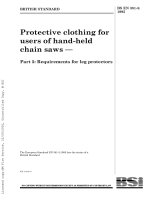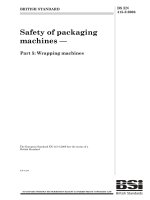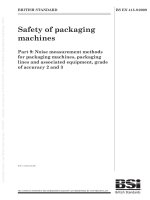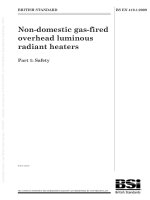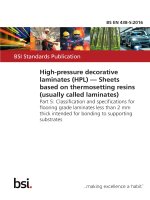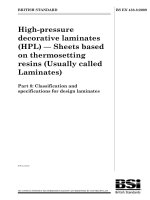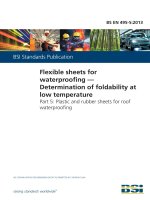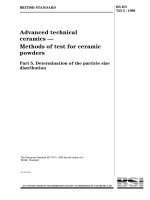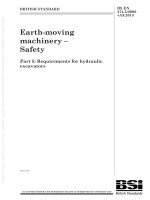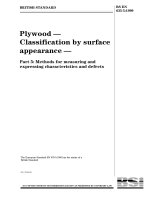Bsi bs en 00623 5 2009
Bạn đang xem bản rút gọn của tài liệu. Xem và tải ngay bản đầy đủ của tài liệu tại đây (1.44 MB, 22 trang )
BRITISH STANDARD
Advanced technical
ceramics — Monolithic
ceramics — General
and textural properties
Part 5: Determination of phase volume
fraction by evaluation of micrographs
ICS 81.060.30
NO COPYING WITHOUT BSI PERMISSION EXCEPT AS PERMITTED BY COPYRIGHT LAW
BS EN 623-5:2009
BS EN 623-5:2009
National foreword
This British Standard is the UK implementation of EN 623-5:2009. It
supersedes DD ENV 623-5:2002 which is withdrawn.
The UK participation in its preparation was entrusted to Technical
Committee RPI/13, Advanced technical ceramics.
A list of organizations represented on this committee can be obtained on
request to its secretary.
This publication does not purport to include all the necessary provisions
of a contract. Users are responsible for its correct application.
Compliance with a British Standard cannot confer immunity
from legal obligations.
This British Standard
was published under the
authority of the Standards
Policy and Strategy
Committee on 31 August
2009
© BSI 2009
ISBN 978 0 580 63844 2
Amendments/corrigenda issued since publication
Date
Comments
BS EN 623-5:2009
EUROPEAN STANDARD
EN 623-5
NORME EUROPÉENNE
EUROPÄISCHE NORM
July 2009
ICS 81.060.30
Supersedes ENV 623-5:2002
English Version
Advanced technical ceramics - Monolithic ceramics - General
and textural properties - Part 5: Determination of phase volume
fraction by evaluation of micrographs
Céramiques techniques avancées - Céramiques
monolithiques - Propriétés générales et textures - Partie 5:
Détermination de la fraction volumique de phase par
évaluation des microphotographies
Hochleistungskeramik - Monolithische Keramik Allgemeine und strukurelle Eigenschaften - Teil 5:
Bestimmung des Volumenanteils von Phasen durch
Auswertung von Mikrogefügeaufnahmen
This European Standard was approved by CEN on 19 June 2009.
CEN members are bound to comply with the CEN/CENELEC Internal Regulations which stipulate the conditions for giving this European
Standard the status of a national standard without any alteration. Up-to-date lists and bibliographical references concerning such national
standards may be obtained on application to the CEN Management Centre or to any CEN member.
This European Standard exists in three official versions (English, French, German). A version in any other language made by translation
under the responsibility of a CEN member into its own language and notified to the CEN Management Centre has the same status as the
official versions.
CEN members are the national standards bodies of Austria, Belgium, Bulgaria, Cyprus, Czech Republic, Denmark, Estonia, Finland,
France, Germany, Greece, Hungary, Iceland, Ireland, Italy, Latvia, Lithuania, Luxembourg, Malta, Netherlands, Norway, Poland, Portugal,
Romania, Slovakia, Slovenia, Spain, Sweden, Switzerland and United Kingdom.
EUROPEAN COMMITTEE FOR STANDARDIZATION
COMITÉ EUROPÉEN DE NORMALISATION
EUROPÄISCHES KOMITEE FÜR NORMUNG
Management Centre: Avenue Marnix 17, B-1000 Brussels
© 2009 CEN
All rights of exploitation in any form and by any means reserved
worldwide for CEN national Members.
Ref. No. EN 623-5:2009: E
BS EN 623-5:2009
EN 623-5:2009 (E)
Contents
page
1
Scope .............................................................................................................................................................. 4
2
Normative references .................................................................................................................................... 4
3
Terms and definitions ................................................................................................................................... 5
4
4.1
4.2
4.3
4.4
4.5
Apparatus ....................................................................................................................................................... 5
Sectioning equipment ................................................................................................................................... 5
Mounting equipment...................................................................................................................................... 5
Grinding and polishing equipment .............................................................................................................. 5
Microscope ..................................................................................................................................................... 5
Transparent grid ............................................................................................................................................ 5
5
5.1
5.2
5.3
5.4
5.5
Test piece preparation .................................................................................................................................. 6
Sampling ......................................................................................................................................................... 6
Cutting ............................................................................................................................................................ 6
Mounting ......................................................................................................................................................... 6
Grinding and polishing ................................................................................................................................. 6
Etching ............................................................................................................................................................ 6
6
6.1
6.2
6.3
6.4
6.5
Photomicrography ......................................................................................................................................... 7
General aspects ............................................................................................................................................. 7
Inspection ....................................................................................................................................................... 7
Number of micrographs ................................................................................................................................ 7
Optical microscopy........................................................................................................................................ 7
Scanning electron microscopy (SEM) ......................................................................................................... 7
7
Measurement of micrographs ...................................................................................................................... 8
8
Calculation of results .................................................................................................................................... 8
9
Interferences and uncertainties ................................................................................................................... 9
10
Test report ...................................................................................................................................................... 9
Annex A (informative) Grinding and polishing procedures ................................................................................. 11
Annex B (informative) Etching procedures ........................................................................................................... 13
Annex C (informative) Use of automatic image analysis (AIA) ............................................................................ 14
C.1
Background .................................................................................................................................................. 14
C.2
Analysis techniques .................................................................................................................................... 14
C.3
Micrograph requirements ........................................................................................................................... 14
C.4
Calibration .................................................................................................................................................... 14
Annex D (informative) Setting Köhler illumination in an optical microscope .................................................... 15
D.1
Purpose ......................................................................................................................................................... 15
D.2
Definition ...................................................................................................................................................... 15
D.3
Setting up for Köhler illumination .............................................................................................................. 15
Annex E (informative) Round robin verification of this procedure ..................................................................... 16
Annex F (informative) Results sheet ...................................................................................................................... 17
Bibliography .............................................................................................................................................................. 18
2
BS EN 623-5:2009
EN 623-5:2009 (E)
Foreword
This document (EN 623-5:2009) has been prepared by Technical Committee CEN/TC 184 “Advanced technical
ceramics”, the secretariat of which is held by BSI.
This European Standard shall be given the status of a national standard, either by publication of an identical text or
by endorsement, at the latest by January 2010, and conflicting national standards shall be withdrawn at the latest
by January 2010.
Attention is drawn to the possibility that some of the elements of this document may be the subject of patent rights.
CEN [and/or CENELEC] shall not be held responsible for identifying any or all such patent rights.
This document supersedes ENV 623-5:2002.
EN 623 consists of five parts, under the general title "Advanced technical ceramics - Monolithic ceramics - General and
textural properties":
Part 1: Determination of the presence of defects by dye penetration
Part 2: Determination of density and porosity
Part 3: Determination of grain size and size distribution (characterized by the Linear Intercept Method)
Part 4: Determination of surface roughness
Part 5: Determination of phase volume fraction by evaluation of micrographs
According to the CEN/CENELEC Internal Regulations, the national standards organizations of the following
countries are bound to implement this European Standard: Austria, Belgium, Bulgaria, Cyprus, Czech Republic,
Denmark, Estonia, Finland, France, Germany, Greece, Hungary, Iceland, Ireland, Italy, Latvia, Lithuania,
Luxembourg, Malta, Netherlands, Norway, Poland, Portugal, Romania, Slovakia, Slovenia, Spain, Sweden,
Switzerland and the United Kingdom.
3
BS EN 623-5:2009
EN 623-5:2009 (E)
1
Scope
This part of EN 623 specifies a manual method of making measurements for the determination of volume fraction of
major phases in advanced technical ceramics using micrographs of polished and etched sections, overlaying a square
grid of lines, and counting the number of intersections lying over each phase.
NOTE 1
This method assumes that the true phase volume fractions are equivalent to area fractions on a randomly cut crosssection according to stereological principles.
NOTE 2
Guidelines for polishing and etching of advanced technical ceramics can be found in Annexes A and B.
The method applies to ceramics with one or more distinct secondary phases, such as found in Al2O3/ZrO2, Si/SiC,or
Al2O3/SiCw.
If the test material contains discrete pores, these can be treated as a secondary phase for the purpose of this method
provided that there is no evidence of grain pluck-out during polishing being confused with genuine pores.
NOTE 3
If the material contains more than about 20 % porosity there is a strong risk that the microstructure will be damaged
during the polishing process, and measurement of volume fraction of pores may become misleading.
Secondary phase volume fractions or porosity present at levels of less than 0,05 are subject to considerable error and
potential scatter in results. A larger number of micrographs than the minimum of three is normally needed to improve
the consistency and accuracy of the results.
NOTE 4
Many ceramics contain small amounts of secondary glassy phases. In order to make a reasonable estimate of
glassy phase content, the glass material between crystalline grains should be readily observable, and thus should be at least
0,5 µm in width. The method in this European Standard is not considered appropriate for narrow glassy films around grains.
This method assumes that the selected regions of a prepared cross-section are statistically representative of the whole
sampled section.
NOTE 5
Microstructures are seldom homogeneous, and the phase contents can vary from micrograph to micrograph. It is
essential to survey a sufficiently wide area of the prepared section to ensure that those areas selected for evaluation are
representative, and do not contain eye-catching irregularities.
Some users of this European Standard can wish to apply automatic or semiautomatic image analysis to micrographs or
directly captured microstructural images. This is currently outside the scope of this European Standard, but some
guidelines are given in Annex C.
2
Normative references
The following referenced documents are indispensable for the application of this document. For dated references,
only the edition cited applies. For undated references, the latest edition of the referenced document (including any
amendments) applies.
EN 1006, Advanced technical ceramics - Monolithic ceramics - Guidance on the selection of test pieces for the
evaluation of properties
EN ISO/IEC 17025, General requirements for the competence of testing and calibration laboratories (ISO/IEC
17025:2005)
4
BS EN 623-5:2009
EN 623-5:2009 (E)
3
Terms and definitions
For the purposes of this part of EN 623, the following terms and definitions apply.
3.1
phase volume fraction
volume occupied by a distinct, identifiable phase present in a material expressed as a fraction of the whole
3.2
secondary phase
one or more distinct identifiable phases other than a primary crystalline phase in a material
NOTE
A secondary phase can be in the form of discrete grains, or as a continuous phase surrounding some or all the
major phase grains. For the purposes of this European Standard, porosity may be treated as a secondary phase.
4
Apparatus
4.1
Sectioning equipment
A suitable diamond-bladed cut-off saw to prepare the initial section for investigation. The saw shall be metal bonded
with a diamond grit size of 125 µm to 150 µm and shall be cooled.
NOTE
4.2
This grit size is designated D151 according to ISO 6106, see [1].
Mounting equipment
Suitable metallurgical mounting equipment and media for providing firm gripping of the test piece for polishing.
4.3
Grinding and polishing equipment
Suitable grinding and polishing equipment, employing diamond abrasive media.
NOTE
4.4
A sequence of abrasives and techniques recommended for polishing are given in Annex A.
Microscope
An optical or scanning electron microscope with photomicrographic facilities.
NOTE
Although the true magnification of the image is unimportant for making the measurement of volume fraction, it is
advised that a reference graticule may be used to determine magnification in an optical microscope, or a reference grid or latex
spheres may be used for calibration of magnification in a scanning electron microscope, and as a check on the homogeneity of
magnification across the field of view.
An optical microscope is additionally required for assessing polishing (see 5.4).
4.5
Transparent grid
Transparent square grid on, e.g. acetate film, and with line thickness not exceeding 0,1 mm.
NOTE 1
The grid spacing selected is not critical, but may conveniently be between 3 mm and 15 mm to minimise eyestrain.
However, it is necessary that consideration of the requirements of 6.3 is taken into account.
NOTE 2
A suitable grid may be prepared as a computer plot with sufficient accuracy of line spacing for the purposes of this
European Standard.
5
BS EN 623-5:2009
EN 623-5:2009 (E)
5
5.1
Test piece preparation
Sampling
The test pieces shall be sampled in accordance with the guidelines given in EN 1006, and subject to agreement
between parties.
NOTE
Depending on the objectives of performing the measurement, it is desirable to maintain knowledge of the positions
within components or test pieces from which sections are prepared.
5.2
Cutting
The required section of test-piece shall be cut using the diamond saw (see 4.1).
NOTE
For routine inspection of materials, a small area of side no more than 10 mm is normally adequate as the section to
be polished.
5.3
Mounting
Mount the test piece using an appropriate mounting medium. If the ceramic is suspected to have significant open
porosity in some regions (see Clause 1) it is advisable to vacuum impregnate the test piece with liquid mounting resin
before encapsulating as this will provide some support during grinding and polishing.
NOTE
It is not essential to encapsulate the test piece. For example, it could be affixed to a metal holder. However,
encapsulation in a polymer-based medium allows easy gripping and handling, especially of small irregularly shaped test pieces
and of weak friable test pieces. The method of mounting selected should take into account the etching procedure to be used;
see Annex B.
5.4
Grinding and polishing
Grind and polish the surface of the test piece. Care should be taken to ensure that grinding produces a planar surface
with a minimum of damage. Employ successively smaller grit sizes, at each stage removing the damage from the
previous stage until there is no change in appearance when examined by an optical microscope (see 4.4) at high
magnification. At least 90 % of the test piece area shall be free from optically visible scratches, or other damage
introduced by polishing, which will interfere with the determination. In particular, discrete secondary phases may be
plucked out from the surface giving the appearance of pores. This shall be avoided.
NOTE
Care should be taken in choosing the sequence of grits and lap types. It is impossible within the scope of this part of
EN 623 to make specific recommendations for all types of material. The general principle to be adopted is the minimisation of
subsurface damage, and its removal by progressively finer grits whilst retaining a flat surface. Some guidelines on polishing are
given in Annex A.
5.5
Etching
When a good quality polished surface has been achieved, the test piece shall be etched if necessary to reveal the
individual phases. Any suitable technique shall be used, subject to agreement between parties.
NOTE 1
Some general guidelines recommending etching procedures for various commonly available advanced technical
ceramics are given in Annex B.
NOTE 2
For optical evaluation, it is usually necessary to etch oxide materials in such a way that the individual phases are
distinguished by having different contrast levels. For evaluation by scanning electron microscopy (SEM), it may not be
necessary to etch if a backscattered electron detector is used which has adequate resolution of net atomic number difference
between the phases such that contrast is generated. If a secondary electron detector is used, it will usually be necessary to etch
to produce topographic contrast unless the atomic number difference between the phases is large.
6
BS EN 623-5:2009
EN 623-5:2009 (E)
6
Photomicrography
6.1
General aspects
If it suspected that the average grain size of each phase or the widths of continuous glassy phases between grains is
less than 2 µm, it will be necessary to prepare the test piece for SEM. Between 2 µm and 4 µm either SEM or optical
microscopy may be used. Otherwise, optical microscopy will normally be adequate.
It is important to achieve sufficient contrast between phases in order to identify individual grains clearly and
unambiguously.
6.2
Inspection
Inspect the sampled cross-section in the microscope. If the microstructure appears homogeneous, prepare
micrographs from randomly selected areas. If inhomogeneity of microstructure is suspected, select representative
areas of relevance for measurement.
6.3
Number of micrographs
At least three micrographs shall be prepared at a magnification sufficient to identify clearly all the phases to be counted.
In addition, at least 100 features in total of any given type shall be present to be counted in the set of micrographs.
NOTE
For a nominally homogeneous material, it may be sufficient to use a small number of micrographs analysed with a
small grid spacing, but for an inhomogeneous material, results representative of the average for the sampled section can be
prepared reliably only by selecting a large number of micrographs of different areas, with less intensive counting from a larger
grid.
6.4
Optical microscopy
Set up Köhler illumination in the microscope.
NOTE
Guidance on setting Köhler illumination conditions is given in Annex D.
Examine the test piece at a magnification sufficient to resolve the individual grains clearly. If the contrast obtained is
insufficient, e.g. in white or translucent materials, apply a suitable thin metallic coating by evaporation or sputtering.
Prepare micrographs of at least three different randomly selected areas of the test-piece surface, taking into account
the apparent homogeneity of the microstructure (see 6.2). As a guideline, the average size of discrete phase area to be
counted should appear typically at least 3 mm across. If the total number of individual grains of any one phase to be
counted in any one set of micrographs is less than one hundred, prepare more micrographs. Micrographs should be
typically of a size (100 x 75) mm, but may with advantage be enlarged later to aid evaluation.
6.5
Scanning electron microscopy (SEM)
Mount the test piece on the test piece holder of the microscope. If the test piece is not electrically conducting, apply a
thin evaporated or sputtered conductive coating. Insert the test-piece in the microscope, ensuring that the surface to be
characterised is normal to the electron beam to within 5°.
NOTE 1
This ensures that the image does not suffer from excessive distortion or loss of focus due to the angle of viewing.
Prepare micrographs at a suitable magnification (see 6.4) from at least three different randomly selected areas of the
test piece, using either secondary electron imaging or backscattered electron imaging.
NOTE 2
Although the contrast between phases can be enhanced using backscattered electron imaging, a noisier image than
in secondary electron imaging may result and may render the boundaries between contrasting phases indistinct. It can be
helpful to use secondary electron images for counting the phase proportions, but backscattered images to aid identification of
each phase.
7
BS EN 623-5:2009
EN 623-5:2009 (E)
If the number of grains of the phase to be counted is less than 100 in total over all the micrographs, increase the
number of areas photographed. Micrographs should typically be of a size (100 x 75) mm, but may with advantage be
enlarged later to aid evaluation.
NOTE 3
It is possible that the photographic screen in the microscope will not have constant magnification at all points. A
square grid makes a suitable reference for ascertaining the degree of distortion in the screen, since it is easy to detect
distortions of the grid. For the purposes of this test method, distortions of typically up to 5 % may be acceptable provided that
the phases being counted are distributed homogeneously across the entire area of the micrograph.
7
Measurement of micrographs
If desirable, enlarge the photomicrograph to a size suitable for easier observation of the features. Examine the
dimensions of the smallest features to be counted. Select a suitable grid spacing and prepare a square grid (see 4.5,
6.3 and comments in Clause 9) such that the grid area covers the entire micrograph.
Tape the micrograph to a smooth surface. Overlay the grid such that the entire area of the micrograph is covered by
the grid, with no grid intersections immediately over the edges of the micrograph. Count the number of grid
intersections nj of the grid that lie over each phase j. If the grid intersection lies exactly over the boundary between two
phases, count this as one half of a grid intersection for each phase. If porosity is to be estimated, use the same rule for
when a grid intersection lies exactly on the edge of a pore. Count the total number of grid intersections over the area of
the micrograph. If pores are not being counted, count the number of grid intersections lying over the crystalline or
glassy phases in the material.
NOTE
It can be helpful in counting to screen with pieces of paper those lines of intersections above and below the one
being counted; this reduces eye strain and the risk of miscounting.
8
Calculation of results
For the case where porosity is to be counted as one of the phases, calculate the volume fraction of each phase using
Equation (1):
Vf j=
nj
(1)
N
where
nj
is the total number of grid intersections over phase j;
N
is the total number of grid intersections lying over the micrograph.
For the case where porosity is to be ignored, see Equation (2):
nj
nj
=
Vf j=
S
(N - n p )
where
8
nj
is the number of grid intersections lying over solid phase j;
np
is the number of grid intersections lying over pores;
(2)
BS EN 623-5:2009
EN 623-5:2009 (E)
S
9
is the sum of all grid intersections lying over all solid phases.
Interferences and uncertainties
The nature of the microstructure of the material can affect the result determined in this test. The test is effective when a
sufficient number of grid intersections of each phase are counted. This can be achieved either by intensive analysis of
the minimum number of three micrographs, or by less intensive analysis of a larger number of micrographs. For
intensive analysis, the grid shall be small enough such that there is a good chance that a grid intersection will lie over
each grain. Failure to do this means that the results are subject to increasing possible random error depending on
exactly where the grid is positioned. The random error is minimised by adhering to the above guideline, but will always
exist because of random positioning of the grid on the micrograph. Typically, for a homogeneous material with
randomly distributed phases results from a given series of three micrographs counting at least 100 grains of each type
should give phase volume fractions consistent to ± 0,02.
If the material appears inhomogeneous, either more areas should be analysed intensively to establish the extent of the
inhomogeneity, or if an average result only is required, a larger grid spacing can be used for less intensive analysis
provided that at least 100 grains of each phase type in total are counted. The procedure adopted should be reported.
The counting process requires visual observation of the phase lying underneath each grid intersection. Clean, welldefined phase boundaries are required. If the phase boundaries are poorly defined as a result of limited optical or SEM
resolution, it is necessary to adopt a consistent criterion for assessing which side of the true boundary the grid
intersection overlies. Failure to do this can lead to under or overestimation of phase volume fraction, and is particularly
dangerous for small volume fractions.
The micrographs should not contain features which are ambiguous. Grain pluckout during polishing could inadvertently
be treated as porosity and, vice versa, features seen within shallow pores might be counted as solid grains. Particular
caution should be taken to avoid subsurface grains giving strong signals in backscattered electron images, or edge
highlights in secondary electron images hiding individual grains.
NOTE
Annex E contains information from a round robin activity associated with the development of this European
Standard which illustrates these concerns.
10 Test report
The report of the test shall be in accordance with the reporting provisions of EN ISO/IEC 17025 and shall include at
least the following information:
a)
name and address of the testing establishment;
b)
date of the test;
c)
on each page, a unique report identification and page number;
d)
customer name and address;
e)
reference to this European Standard, i.e. determined in accordance with EN 623-5;
f)
authorizing signature;
NOTE 1
For routine presentation of results it is useful if a standardised format is adopted. A recommended scheme is given
in Annex F.
g) any deviation from the method described, with appropriate validation, i.e. demonstrated to be acceptable to the
parties involved;
h)
details of the test piece, including material type, manufacturing code, batch number, etc.;
i)
observation technique employed (optical or scanning electron microscope);
9
BS EN 623-5:2009
EN 623-5:2009 (E)
j)
a summary of the procedure for sampling, cutting, grinding, polishing and etching the test piece;
k)
copies of the micrographs used for the measurements;
NOTE 2
It is good practice to provide magnifications on all micrographs, even though not a requirement of this European
Standard.
l)
grid size employed;
m) number of grid intersections lying over each of the defined phases, including pores if appropriate, on each of the
micrographs;
n)
total number of grid intersections on each micrograph;
o) calculated volume fractions of each phase in each micrograph, and the overall result from all micrographs,
expressed as a decimal number to two significant figures;
p)
10
any remarks on the appearance of the microstructure, and difficulties of observing the individual phases.
BS EN 623-5:2009
EN 623-5:2009 (E)
Annex A
(informative)
Grinding and polishing procedures
Preparation of polished sections of ceramics requires different procedures from those conventionally employed for
metallic materials, which typically commence with a coarse grinding stage using fixed grit silicon carbide papers of grit
sizes of 30 µm or greater (see [1] for information on grit size coding). For ceramic materials, this type of procedure can
produce considerable amounts of sub-surface damage in the form of extended microcracks which can then influence
the microstructural appearance obtained, unless precautions are taken to minimise such damage and to remove all
traces of it in subsequent grinding steps. Unless care is taken, the final surface may contain damage which manifests
itself as microcracks and grain tear-out, the presence of which can influence the results of any microstructural
characterisation measurement. Thus, selection of appropriate polishing procedures, including the sequence of grit
sizes, the times of abrasion and the applied pressure are all important. Optimum conditions vary considerably
depending on the type of material being prepared. Guidelines on how to choose a grinding method may be found in
Hübner and Hausner (see [2]).
As an example, a series of metal-bonded diamond grinding discs give high material removal rates for initial flattening.
However, grit sizes greater than 30 µm may introduce damage, especially in materials of poor toughness, and smaller
grit sizes used for longer periods of time may produce a better result. Loose diamond abrasives remove material more
slowly than grit of the same size fixed in a disc, and may cause more damage. Subsequent grinding steps may need to
be of longer duration. The use of a shock-absorbing system, such as a soft metal lap (e.g. tin) into which loose grit
becomes lodged, or a metal-plastic composite lap with fixed diamond grit, gives a good balance between speed of
abrasion and surface damage.
The grinding of silicon carbide ceramics can cause special difficulties. Klimek (see [3]) recommends that the diamond
abrasive used should not be larger than 6 µm, since a larger size of abrasive tends to shatter large SiC grains rather
than to produce cutting.
After a planar surface is achieved with the initial grinding stage, a sequence of finer grit sizes may be employed to
remove grinding damage from previous steps. The precise sequence of stages chosen will depend on equipment
available, and may have to be optimized for each type of material. The general principle should be that each step
should be of sufficient duration to remove evidence of damage from the previous stage. The final polishing stage
should not be undertaken until a good quality finish is obtained. The use of napped cloths for polishing is not
recommended because on many types of ceramic it can cause pluck-out of grains (especially with high-alumina
ceramics) or loss of flatness of surface. Polishing procedures have been described by Clinton (see [4]). A series of
articles on microstructural preparation of ceramics with polishing details is given in [5].
The following five-stage procedure is recommended as a starting point for fine-grained ceramics, and gives surfaces of
sufficient quality for examination at high magnification in the scanning electron microscope:
1)
30 µm diamond on a hard composite lap;
2)
6 µm diamond on a softer composite lap;
3)
1 µm diamond on a hard napless cloth (or a tin lap);
4)
0,25 µm diamond on a hard napless cloth;
5)
colloidal silica in alkaline solution on a hard napless cloth.
The last step is intended to remove scratches from the polished surface, which it does very successfully. However,
there is a risk of pores becoming filled with polishing debris which is impossible to remove, and this step should not be
used if evaluation of porosity content is required. Such pick-up should not influence grain size measurement. It is
recommended that the lap is kept wet at all times, and that polishing is continued with water for a short while at the
end to prevent the build-up of deposits on the surface.
11
BS EN 623-5:2009
EN 623-5:2009 (E)
Before moving from one stage to the next, the test piece should be carefully cleaned of abrasive grit using an ultrasonic
bath and a suitable liquid cleaning agent, and should be examined in an optical microscope to ensure the surface is
uniform and that damage from the previous stage is minimised.
12
BS EN 623-5:2009
EN 623-5:2009 (E)
Annex B
(informative)
Etching procedures
With many ceramic materials it is necessary to reveal the positions of grain boundaries for the purpose of this test. A
variety of techniques are available for doing this, but the choice and the severity of the process may depend on the
precise nature of the material and the technique used to observe the microstructure. Some experimentation is often
needed to set appropriate conditions for unfamiliar materials. Over-etching is to be avoided, since it can modify the
appearance of the microstructure. It is recommended that the optimum etching conditions are determined in a stepwise fashion to ensure that over-etching does not occur. It can be necessary to use more severe etching for SEM
images than for optical images in order to produce adequate contrast at grain boundaries.
Bibliographic lists of etching methods have been given by Clinton and Petzow (see [4] and [6]), and further information
is given in [7] to [9]. Table B.1 gives examples.
Table B.1 – Examples of etching methods
Ceramic
Method
Conditions
Alumina (> 99,5 %)
Thermal
1 500 °C, 2 h (see text)
Alumina (lower purity)
Chemical or thermal
10 % HF, 20 s; 1 450 °C, 1 h (see text)
Zirconia-toughened
alumina
Thermal
1 500 °C, 15 min (see text)
Yttria-Tetragonal zirconia
polycrystals (TZP)
Thermal
1 300 °C, 2 h to 1 420 °C, 15 min (see
text)
Ce-TZP
Thermal
1 450 °C, 5 min (see text)
Sialons and sintered
silicon nitrides
Plasma etch (see [10]
and [11])
CF4 plasma etch, 40 s
Hot-pressed silicon
nitride
Chemical
NaOH, 400 °C - 450 °C, 1 min – 10 min
CF4 plasma etch, 40 s
Aluminium nitride
Relief polished
Colloidal silica, alkaline solution
Sintered silicon carbide
Chemical
Modified Murakami's reagent, e.g. 3 g
KOH, 30 g K3Fe(CN)6, 60 ml H2O, boil
for 2 min to 20 min.
Thermal etching used for oxide ceramics can give good clear delineation of grain boundaries, but there is a risk of
modifying the microstructure of the product in the process. The maximum temperature for this process should be at
least 150 °C below the original firing temperature of the ceramic (for the same time period) to minimise the risks. In
addition, the presence of glassy secondary phases can cause problems of contamination of the grain surfaces as it is
usually mobile at the required thermal etching temperatures.
Chemical methods, particularly those involving melts, can be difficult to control and reproduce. Ensure that the test
piece is clean and free from grease before using aqueous etchants. If a test piece is over-etched, smaller grains can
disappear. Ceramics with continuous secondary phases are generally more easily etched than those without, but
caution is required if the primary phase is also continuous, e.g. in reaction-bonded silicon carbide, or in some highalumina ceramics. It is possible that the true grain boundaries will not all be revealed.
Many etching processes, particularly thermal etching, will require that the test piece mounting or impregnation medium
is removed beforehand.
13
BS EN 623-5:2009
EN 623-5:2009 (E)
Annex C
(informative)
Use of automatic image analysis (AIA)
C.1 Background
There is increasing use of automatic image analysis for estimating phase volume fraction, but there is not yet sufficient
experience of analysis procedures to permit a standard to be prepared. The following gives information on possible
suitable procedures evaluated during the course of the study reported in Annex E.
C.2 Analysis techniques
Depending on the supplied software, there are a number of techniques that can be programmed into automatic image
analyzers, but all rely on digitisation of the captured image. The original analogue image in the microscope is usually
captured via a video camera or micrograph scanning device and is converted into a series of pixels which contain
information on position and brightness/intensity. The series of pixels can be interrogated, for example, to count all those
with a given brightness. The number counted, divided by the total number of pixels in the image gives the volume
fraction. Alternatively, the image can be sampled in the same way as the manual method by selecting only a small
proportion of the total number of pixels representing the intersections of a grid. Other methods suitable when the phase
brightness in the image is inconsistent involve a manual stage where boundaries are drawn manually around each of
the identified phases, rather than relying on selecting a brightness level or range of levels. It is recommended that
allowance is made for apparent grain boundary width, which can with advantage be narrowed electronically to reduce
the possible counting error.
C.3 Micrograph requirements
In order to minimise the need for human interaction in the process, it is desirable to acquire micrographs which have
uniform brightness across each phase. It is possible that this will not be easy to achieve. In the optical microscope, it is
recommended that the illumination of the field of view is very even. The contrast established in the scanning electron
microscope should be very uniform with a minimum of edge brightness or etched grain boundary topographic width in
secondary electron images, which is best achieved by using low voltages. Alternatively, backscattered electron images
eliminate undesirable edge brightness, but there is an increase in noise. As shown by the round robin reported in
Annex E, in a good image, the scatter between laboratories is similarly as low as that achieved using the manual
method, but when the image contains phases showing wide intensity variations that do not prevent their correct
identification by the human eye, the scatter between laboratories using AIA is much wider.
C.4 Calibration
There is currently no means of checking that an AIA system is giving the correct results, except for when black and
white images are used (a trivial case). The options for programming within AIA systems should be checked out using
such an image. The ability of the system and its user to obtain correct results should be checked by using manually
evaluated micrographs. In this way, a check can be made that intensity level variations across grains and at phase
boundaries are being correctly assessed.
14
BS EN 623-5:2009
EN 623-5:2009 (E)
Annex D
(informative)
Setting Köhler illumination in an optical microscope
D.1 Purpose
The principal purpose behind setting up the correct illumination is to ensure that the intensity across the image width is
uniform for the purposes of photomicrography.
D.2 Definition
Köhler illumination is achieved when an image of the illumination source is projected by a collecting lens into the plane
of the aperture diaphragm positioned in the front focal plane of the condenser lens. This latter lens, in turn, projects an
image of the illuminated field diaphragm at the condenser lens into the object plane.
D.3 Setting up for Köhler illumination
The following instructions are the basic principles. Different microscopes may have different means of achieving these
steps, and reference to the equipment handbook is recommended.
Switch on the illumination system. Choose a reflective specimen, e.g. a metal graticule, and a low magnification
objective lens, typically x 10. Focus the microscope on the specimen in the normal way. Fully open the condenser
aperture iris. Remove the eyepiece and sight down the microscope tube. Observe the image of the lamp filament in the
back focal plane of the objective (alternatively, if fitted, a Bertrand lens can be introduced and this image observed
without removing the eyepiece). Adjust the lateral position of the lamp filament until it appears centrally in the field of
view. Adjust the condenser lens position (or the lamp collector lens, depending on the system design) until the image is
sharp and in focus at the same time as the condenser iris diaphragm. Replace the eyepiece (or remove the Bertrand
lens). Close the collector lens aperture until the field of view begins to darken, and then open it a little. The objective is
now collecting the maximum angle cone of light without excess scattering or internal reflections.
If the objective lens is subsequently changed, the optimum Köhler illumination should be checked unless it has
previously been established that the same positions of adjustment apply to all lenses in the instrument.
15
BS EN 623-5:2009
EN 623-5:2009 (E)
Annex E
(informative)
Round robin verification of this procedure
Background research and a round robin developed in conjunction with this European Standard were targeted at setting
the conditions for measurement using the manual grid method and at evaluating the repeatability of the method
amongst a number of participants. The findings can be summarised as follows:
1)
in a manual method simulation using automatic image analysis, it was shown that the volume fractions as
determined by counting the fraction of grid intersections lying over each phase converged to consistent values
when the grid spacing was approximately the apparent phase grain size in the micrograph. Employing larger grid
spacings than this gave results strongly dependent on grid spacing and position over the micrograph;
2)
in the round robin set up to operate under the conditions described above, the manual method reveals statistically
consistent and reproducible results when applied to single micrographs of a two-phase barium titanate ceramic
and an alumina/5 % zirconia ceramic. The standard deviation of the volume fraction results was within ± 2,5 %
(expressed as a phase volume fraction) and the 95 % confidence on mean values from all participants was less
than ± 1,0 %;
3)
the scatter in the results of the manual method was found to be mainly produced by the random positioning of the
grid on a given micrograph, and by the distribution of the phases in each area examined;
4)
the determined volume fractions of a microstructure were found also to be dependent on the exposure conditions
used for preparing the micrograph. Whether using an SEM or an optical microscope, decisions have to be made
concerning the contrast and brightness, the magnification and the representative area of interest;
5)
the variation in apparent volume fraction can be large between individual micrographs of randomly chosen areas.
It was established that it is necessary to make measurements on a representative number of micrographs at
magnification required to obey the criterion in 1) above before convergence of the average result could be
achieved.
16
BS EN 623-5:2009
EN 623-5:2009 (E)
Annex F
(informative)
Results sheet
Testing establishment
Report reference no.
Client name and address
Date of receipt of test piece
Date of test
Test piece reference number
and manufacturing details
Size of sampled ceramic
Number of test pieces
Test piece preparation
Method of cutting
Method of mounting
Method of grinding/polishing
Method of etching
Method of observation
Type of microscope
Method of recording images
Magnification of micrographs
and calibration method, if
available
Results from each micrograph
Phase type
Including/excluding pores
No. of intersections over phase
(1)
(2)
(3)
Total
(1)
(2)
(3)
Total
Phase volume fraction
Overall results from all
micrographs
Phase type
No. of intersections over phase
Phase volume fraction
Remarks
Problems with preparation
Features of microstructure
Micrographs
Signature of person
undertaking the test
Authorising signature
17
BS EN 623-5:2009
EN 623-5:2009 (E)
Bibliography
[1]
FEPA standard for bonded abrasive grains of fused aluminium oxide and silicon carbide, Federation of
European Abrasives manufacturers (FEPA), No. 42-GB-1984 (R1993) (English language version); FEPA
standard for coated abrasive grains of fused aluminium oxide and silicon carbide, ibid, No. 43-GB-1984
(R1993) (English language version). See also: ISO 8468:1996 Bonded abrasives - Determination of
designation and of grain size distribution – Part 1: Macrogrits F4 to F220, and Part 2: Microgrits F230 to
F1200; ISO 6106:1979 Abrasive products – Grain sizes of diamond or cubic boron.
[2]
Hübner, G., Hausner, H., Material-orientated preparation of sintered ceramic bodies, Prakt. Metallogr.,
1983, 20, 289–296.
[3]
Klimek, E.J., Microstructure of silicon carbide materials. Microstructural Science, Volume 16, ASM
International, Monterey, USA, 1987, 295–304.
[4]
Clinton, D.J., A guide to polishing and etching of technical and engineering ceramics, Institute of Ceramics,
Stoke-on-Trent, Staffs, U.K., 1987.
[5]
Carle, V., et al., Ceramography of high-performance ceramics - description of materials, preparation,
etching techniques and description of microstructures: -Part II: Silicon carbide. Prakt. Metallogr., 1991, 28,
420–34. Part III - Zirconium dioxide (ZrO2) (by Schäfer, U., et al.), ibid, 1991, 28, 468–83. Part IV Aluminium nitride (AlN) (by Predel, F., et al.), ibid, 1991, 28, 542–52.
[6]
Petzow, G., Metallographic etching, American Society for Metals, Ohio, USA, 1979.
[7]
Elssner, G., et al., Methoden zur Anschliffspräparation keramischer Werkstoffe, Deutsche Keramische
Gesellschaft, Bad Honnef, 1985.
[8]
Lay, L.A., Corrosion resistance of technical ceramics, HMSO, London, 1984.
[9]
Carle, V., Ceramography of high-performance ceramics - description of materials, preparation, etching
techniques and description of microstructures. Prakt. Metallogr., 1991, 28, 359–77.
[10]
Chatfield, C. and Norstrom, H., Plasma etching of sialon. J. Amer. Ceram. Soc., 1983 64(9), C–168.
[11]
Täffner, U., Hoffman, M.J., Krämer, M., Comparison of different physical/chemical methods of etching for
silicon nitride ceramics. Prakt. Metallogr. 1990, 27, 385–90.
18
BS EN 623-5:2009
This page has been intentionally left blank
BS EN
623-5:2009
BSI - British Standards Institution
BSI is the independent national body responsible for preparing British
Standards. It presents the UK view on standards in Europe and at the
international level. It is incorporated by Royal Charter.
Revisions
British Standards are updated by amendment or revision. Users of British
Standards should make sure that they possess the latest amendments or
editions.
It is the constant aim of BSI to improve the quality of our products and services.
We would be grateful if anyone finding an inaccuracy or ambiguity while using
this British Standard would inform the Secretary of the technical committee
responsible, the identity of which can be found on the inside front cover. Tel:
+44 (0)20 8996 9000. Fax: +44 (0)20 8996 7400.
BSI offers members an individual updating service called PLUS which ensures
that subscribers automatically receive the latest editions of standards.
Buying standards
Orders for all BSI, international and foreign standards publications should be
addressed to Customer Services. Tel: +44 (0)20 8996 9001. Fax: +44 (0)20 8996
7001 Email: You may also buy directly using a debit/credit
card from the BSI Shop on the Website />In response to orders for international standards, it is BSI policy to supply the
BSI implementation of those that have been published as British Standards,
unless otherwise requested.
Information on standards
BSI provides a wide range of information on national, European and
international standards through its Library and its Technical Help to Exporters
Service. Various BSI electronic information services are also available which
give details on all its products and services. Contact Information Centre. Tel:
+44 (0)20 8996 7111 Fax: +44 (0)20 8996 7048 Email:
Subscribing members of BSI are kept up to date with standards developments
and receive substantial discounts on the purchase price of standards. For details
of these and other benefits contact Membership Administration. Tel: +44 (0)20
8996 7002 Fax: +44 (0)20 8996 7001 Email:
Information regarding online access to British Standards via British Standards
Online can be found at />Further information about BSI is available on the BSI website at http://
www.bsigroup.com.
Copyright
BSI Group
Headquarters 389
Chiswick High Road,
London, W4 4AL, UK
Tel +44 (0)20 8996 9001
Fax +44 (0)20 8996 7001
www.bsigroup.com/
standards
Copyright subsists in all BSI publications. BSI also holds the copyright, in the
UK, of the publications of the international standardization bodies. Except as
permitted under the Copyright, Designs and Patents Act 1988 no extract may
be reproduced, stored in a retrieval system or transmitted in any form or by any
means – electronic, photocopying, recording or otherwise – without prior written
permission from BSI.
This does not preclude the free use, in the course of implementing the standard,
of necessary details such as symbols, and size, type or grade designations. If
these details are to be used for any other purpose than implementation then the
prior written permission of BSI must be obtained.
Details and advice can be obtained from the Copyright and Licensing Manager.
Tel: +44 (0)20 8996 7070 Email:
